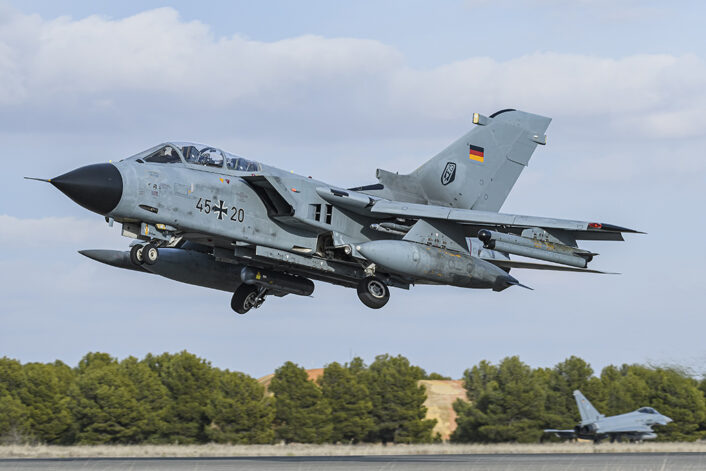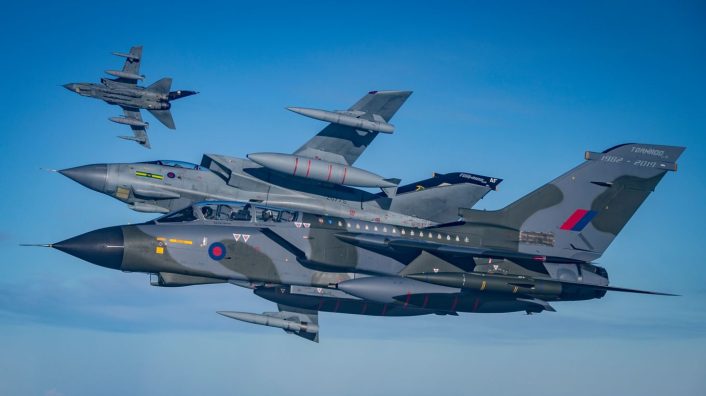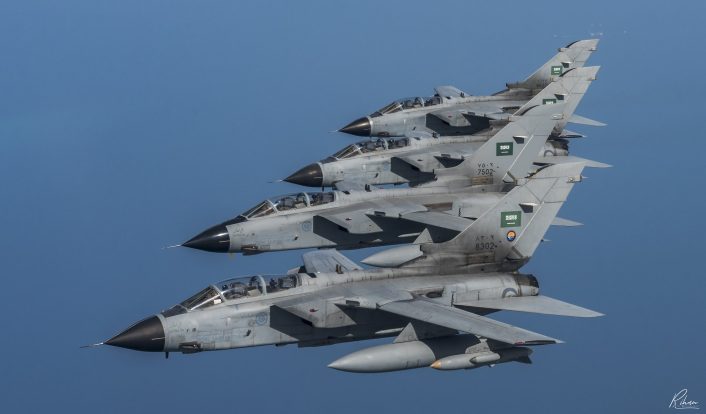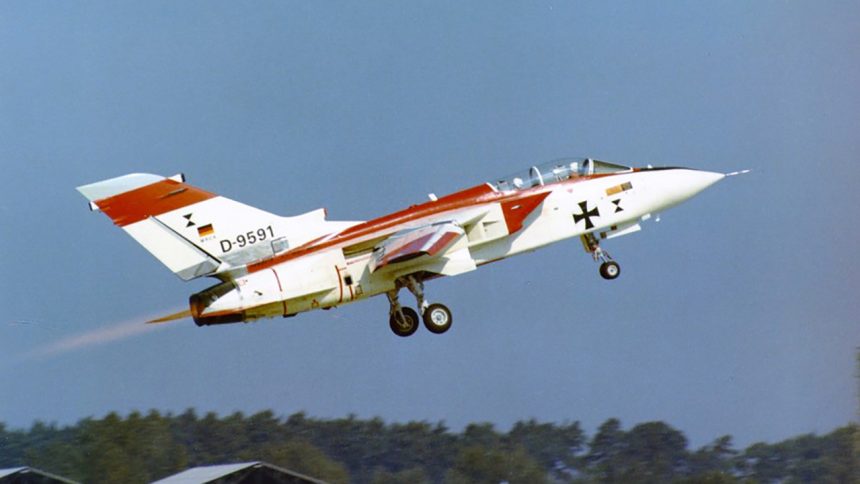Aug. 14, 2024, marks the 50th anniversary of the Panavia Tornado’s first flight, the largest European aeronautical cooperation program with over 950 aircraft built.
The Panavia Tornado, the European variable sweep wing bomber, celebrates this year the 50th anniversary from its first flight on Aug. 14, 1974. On that day, the first prototype, designated as P.01, took off from Manching airport in Germany with an iconic red and white livery, flown by British pilot Paul Millett in the front seat and German pilot Nils Meister in the back seat.
The first flight went on without issues, exceeding the pilots’ expectations. Paul Millett described his experience: “Aircraft handling was delightful… the actual flight went so smoothly that I did begin to wonder whether this was not yet another simulation”.
With over 950 aircraft built, the variable sweep bomber grew to become the largest European aeronautical cooperation program, followed today by the Eurofighter Typhoon. The four partner nations accumulated more than three million flight hours, including combat flights in all the modern conflicts.
50 years ago today, history was made: The first Tornado prototype took off on its first flight. 🛫 Happy birthday to this amazing aircraft! 🥳 We salute your legacy, which will live on in the #Eurofighter and #FCAS for decades to come. pic.twitter.com/FDefoesSEI
— Airbus Defence (@AirbusDefence) August 14, 2024
The Tornado program
Born in the 1960s as the Multi Role Combat Aircraft (MRCA), the Tornado was designed as a twin-engine supersonic twin-seat bomber, with all-weather and low flight capabilities and a distinctive variable sweep wing. The goal was to obtain an aircraft capable of tactical strike missions, reconnaissance, maritime attacks and even air defense.
At the time there were multiple countries looking to replace older aircraft, some of them with international program which did not succeed. In 1968, West Germany, the Netherlands, Belgium, Italy, the United Kingdom and Canada started working on the MRCA, however the Netherlands, Belgium and Canada later pulled out of the project.
The three biggest names in the aerospace industry in Great Britain, Germany and Italy – the British Aircraft Corporation (now BAE Systems), FIAT Aviazione (which went on to become Aeritalia, then Alenia Aermacchi, and is now Leonardo), and MBB (now Airbus DS) – joined forces in the project. The partnership established the Panavia consortium in 1969 and laid the foundations for the birth of a true European aeronautical industry, which went on to establish the Eurofighter programme.
Five years later, in 1974, the first of 15 development aircraft performed its first flight. The flight test campaign allowed to discover and solve some deficiencies, such as severe safety issues of the engines at high altitude while trying to decelerate. Over the course of time, the aircraft also incorporated new features such as more sophisticated stability augmentation systems and autopilots.
The contract that marked the start of the Tornado’s production was signed in 1976, with the first production aircraft flying on Jul.10, 1979. The same year saw also the first flight of the prototype of the Tornado ADV (Air Defence Variant), on Oct. 27, 1979, and the first deliveries to the Royal Air Force and German Air Force. The Italian Air Force received its first Tornado in 1981.
The three air forces joined forces also for the training, opening in 1981 at RAF Cottesmore the Tri-National Tornado Training Establishment (TTTE), which trained pilots until 1999. Saudi Arabia became in 1985 the only export customer of the Tornado. 1988 saw the first flight of the Tornado ECR (Electronic Combat and Reconnaissance).
Australia, Canada, Japan, Taiwan and South Korea considered the Tornado, however they opted for other aircraft in the end. Without foreign orders, the production of the Tornado ended in 1998 after the completion of the Saudi aircraft.

The operators
The Luftwaffe operated three variants of the Panavia Tornado since 1980, when the type entered operational service with the Tornado IDS and IDS(T) (trainer) variants, joined in 1990 by the Tornado ECR. The German Navy also operated the IDS variant until 2005, when they were transferred to the Air Force. In total, Germany had 357 aircraft, of which 255 Tornado IDS, 67 Tornado IDS(T) and 35 Tornado ECR.
Italy operates three variants of the aircraft, which increased to four for decade in the 1990s. In fact, the Aeronautica Militare began operations in 1981 with 87 Tornado IDS and 12 Tornado IDS(T), which were joined in 1993 by 24 Tornado F3 leased by the UK and in 1998 by 16 Tornado ECR converted from IDS models. Both Italy and Germany plan to retire their Tornado aircraft in 2025 and replace them with the F-35A.
#AccaddeOggi ⌛️: il 14 agosto del 1974 all’aeroporto di Manching in Germania, volò per la prima volta il prototipo del velivolo #Tornado. Il primo esemplare assegnato a un reparto operativo dell’#AeronauticaMilitare fu consegnato il 27 agosto 1982 al 154° Gruppo del 6° Stormo. pic.twitter.com/OxOmYvjxGh
— Aeronautica Militare (@ItalianAirForce) August 14, 2024
Saudi Arabia, the only export customer of the European aircraft, operated the most variants among the partner nations. In fact, since 1989, the country fielded 60 Tornado IDS, 24 Tornado IDS(T), 12 Tornado IDS(R) (Reconnaissance), 18 Tornado ADV and six Tornado ADV(T). The latter two variants are now retired, however it is not known how long the other variants will be kept in operations before being replaced by the Eurofighter Typhoon and the F-15SA.
The Royal Air Force, the only service to completely retire the type so far, received 230 Tornado IDS/GR1, of which 142 later upgraded to GR4, 18 Tornado F2 and 147 Tornado F3. The air defense variants were retired in 2011, while the ground attack variants were retired in 2019.

The operational life
The Tornado took part to many major operations since the 1990s. The Italian and British Tornados were the ones who marked the type’s combat debut, deploying to the Middle East for the first Gulf War in 1991. Eight Italian Tornado IDS, 49 British Tornado GR1 and 18 Tornado F3 were deployed, with one Italian Tornado IDS and six British Tornado GR1s lost in combat.
Saudi Arabia also took part in the conflict with both IDS ad ADV variants. The Tornado IDS fleet performed attacks in Iraq similarly to the RAF, while the ADV flew missions mainly over Saudi Arabia. One IDS was lost as it ran out of fuel while diverting because the tanker failed to make its planned refueling rendezvous.
The RAF later took part in Operation Southern Watch and Operation Provide Comfort, first with the Tornado GR1 and later also with the upgraded GR4 at its operational debut. They also took part in coalition strikes at Iraq’s military infrastructure during Operation Desert Fox in 1998, without losses.

The wars in the Balkans saw the employment of the Tornado fleets of all three European partners, with Germany being at the first offensive air mission since World War II when it took part in Operation Allied Force. The Tornado ECR made there its combat debut, with Italy and Germany firing a total of 350 AGM-88 HARM missiles.
The Royal Air Force deployed again the Tornado GR4 as part of Operation Telic, Britain’s contribution to the 2003 invasion of Iraq. The deployment recorded the first use of the Storm Shadow cruise missiles, but also saw a Tornado shot down by friendly fire which killed both crew members.
All three countries deployed their Tornados to Afghanistan. The first were the Germans, with six aircraft deployed to Mazar-i-Sharif in a reconnaissance role in 2007. Italy deployed its Tornado in 2008 to Mazar-i-Sharif also in a reconnaissance role. In 2009, the UK deployed the Tornado GR4s to Kandahar to provide Close Air Support to Coalition forces.

In 2009 Saudi Arabia started employing the Tornado over Yemen, playing a central role along with the F-15. Three Tornado were later lost during the long bombing campaign.
In 2011, the Libyan war saw the UK and Italy enforcing the UN no-fly zone with their Tornados, in a mix of Storm Shadow attacks, CAS, ground strikes and SEAD (Suppression of Enemy Air Defences) missions. Several RAF Tornados flew 4,800 km missions from the UK to Libya in what was later defined as “the longest range bombing mission conducted by the RAF since the Falklands conflict”.
In 2014, the RAF deployed it Tornado GR4s to RAF Akrotiri, Cyprus, performing strikes against Islamic State militants in Iraq and Syria. In the same year, Italy deployed its Tornados to Kuwait to perform reconnaissance missions against the militants.









